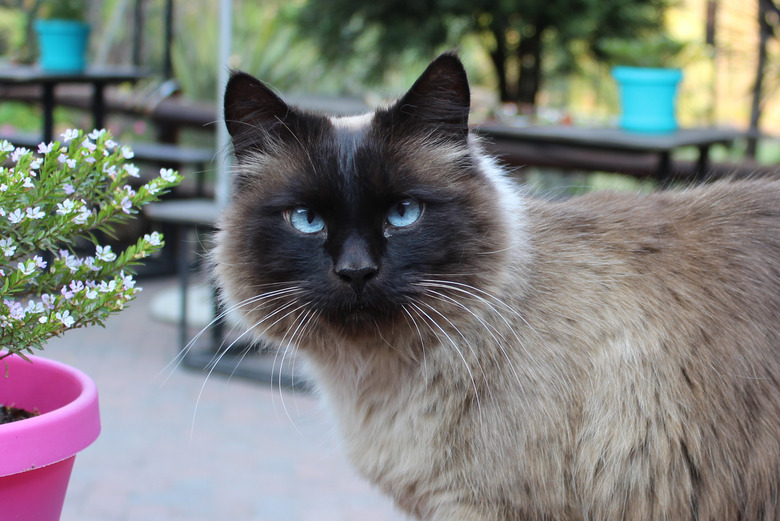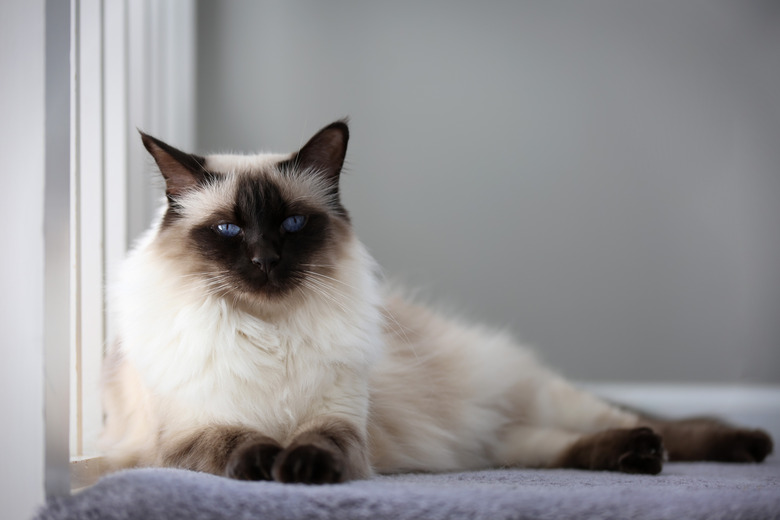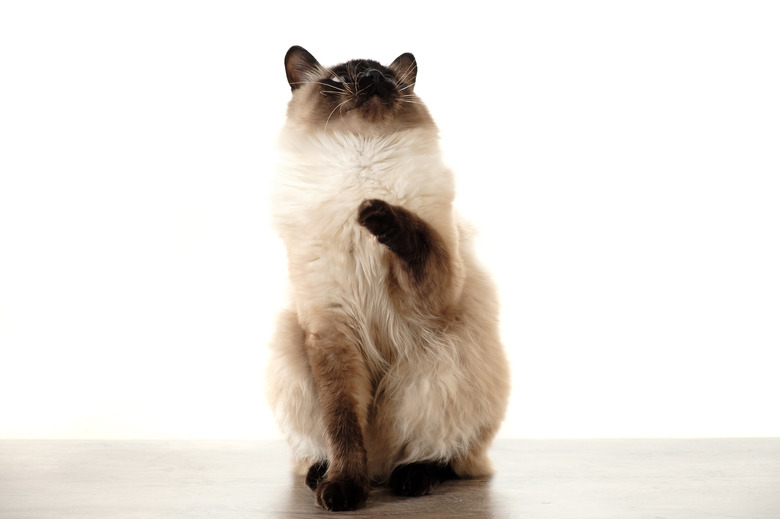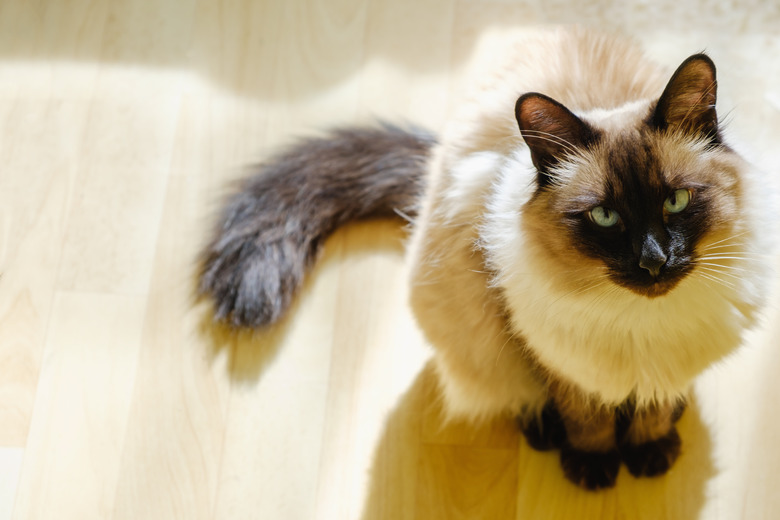Balinese Cat Breed Characteristics
Balinese cat quick facts
Balinese cat quick facts
Length: 12 – 16 inches
Weight: Females: 5 – 8 pounds, Males: 8 – 12 pounds
Lifespan: 12 – 15 years or more
Coat length: Long
Coloring: Blue point, chocolate point, lilac point, and seal point with vivid blue eyes.
Grooming needs: Low
Friendliness: Breed alone is not an accurate predictor of individual cats' personalities. However, Balinese are generally regarded as curious, affectionate, and outgoing.
The name for the Balinese cat was inspired by the grace of the Balinese dancers, although the breed originated in the United States from long-haired Siamese cats. They have a beautiful pointed coat pattern and a silky, long coat and a plumed tail that rarely tangles or mats. And while the breed isn't completely hypoallergenic, they produce less of the Fel d1 protein, the protein that triggers a reaction in people who are allergic to cats, in their saliva.
They are small to medium-sized cats with a combination of personality traits that makes them a joy to have in your home. Consider the breed's personality, energy levels, and care requirements carefully before deciding to bring a new Balinese kitten into your family.
Balinese cat history
Balinese cat history
Today's Balinese cat breed was started in the 1950s by two Siamese breeders, Helen Smith in New York and Marion Dorsey in California, when they found long-haired Siamese kittens in some litters in their breeding programs. Another cat breeder, Sylvia Holland, helped to organize the Balinese breeders so that more crossbreeding could occur between the different lines of Balinese cats.
It is interesting to note that the long-haired Siamese cat's history goes back much further. In 1928, a long-haired Siamese was registered with the Cat Fanciers' Association (CFA) and a long-haired Siamese was featured in the 1871 edition of the "Penny Illustrated" newspaper.
The Cat Fancier's Association recognized the breed with the same four colorpoint colors as the shorthair Siamese cat including blue point, chocolate point, lilac point, and seal point. The association later merged the Javanese cat breed with the Balinese breed. They also started recognizing additional colors and coat patterns under the Javanese division. This included solid point, lynx point, and parti-color point patterns. Balinese cats also have blue, almond-shaped eyes, wedge-shaped heads, and large ears.
Balinese cat personality
Balinese cat personality
Balinese cats are social and outgoing cats. They are sure to be loving with all members of your family and can do well in homes with children and other pets. They don't tend to be lap cats, but they are quite affectionate. They may stick close to help you as you move around the house.
Like the Siamese, the Balinese cat is vocal and will often speak to you. They tend to have a softer meow compared to Siamese cats.
The breed is also intelligent and inquisitive. These athletic cats need plenty of play and activity to stay happy and out of trouble. Interactive toys and teaser toys are good options for entertaining the Balinese cat.
You can also burn off some energy and deepen your relationship with your cat by training them to play fetch, walk on a leash, or participate in sports like agility. Just be sure to use plenty of positive reinforcement during the play and training sessions.
Balinese cat lifespan and health issues
Balinese cat lifespan and health issues
The purebred Balinese cat breed generally lives into their teens. Some may even live 20 years or more. Balinese are generally a healthy breed with few health problems. These cats can be more sensitive to anesthesia than other breeds, so it is important to discuss this with your veterinarian before any surgical procedure.
The cats may suffer from amyloidosis, a condition that causes a build-up of amyloid proteins in the organs, often the kidneys. Unfortunately, there is no genetic test for this condition.
As the breed was developed from a Siamese cat, they may also have some of the same health risks and conditions. These include having crossed eyes and kinked tails. These conditions are both considered faults under the breed standard, but they don't generally affect the cat's life expectancy.
Balinese cat grooming and care
Balinese cat grooming and care
Balinese cats have long hair but are surprisingly easy to groom. Unlike many other longhaired cats, they do not have an undercoat which gives them a very sleek appearance. They have a silky coat that rarely sheds. All you need to do to keep your cat's coat healthy is brush or comb it on a weekly basis.
Other weekly grooming tasks include:
- cleaning the ears
- cleaning the eyes with a damp cloth
- trim the nails
Also, be sure to brush the cat's teeth regularly. Use a toothpaste that is veterinary-approved for use in pets. Feed high-quality cat food, preferably canned food twice per day in the amount recommended by your veterinarian. Make sure fresh drinking water is available at all times.
Welcoming a new cat into your home
Welcoming a new cat into your home
Balinese cats are sociable cats, but coming into a new environment with new people and smells can be stressful — even the most relaxed of cats. Make the transition a smooth one by cat-proofing your home before your Balinese kitten's arrival.
Set up a room where you can welcome your new cat. Make sure it has everything your new cat will need including:
- food and water
- litter box
- scratching post
- cat tree
- toys
In addition, make sure to close off any spaces where a scared cat may hide and get stuck such as gaps between the wall and furniture or appliances. Allow your new cat or kitten to explore the room and get used to the space. Spend plenty of time sitting with your cat and talking to them, but don't force them to be petted or held. With patience and positive reinforcement, your new cat will warm up to you in no time.
If you also have other pets or small children in the home, this is a good time for introductions. Having the new cat in a separate room ensures there won't be conflict during the first meeting and the new cat has a safe space to retreat to if they get overwhelmed.
The Balinese cat tends to be quite outgoing, so it won't be long before they are ready to leave the room — and become an active member of the family.



